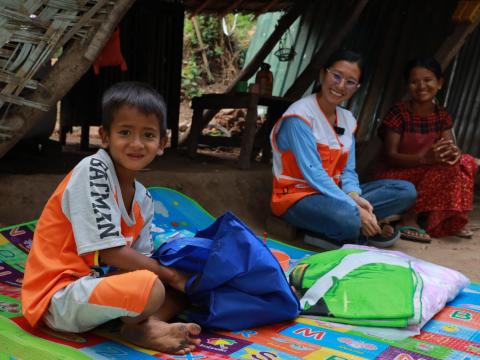Vital Food Aid Alleviates the Urgent Needs of Earthquake-Affected Families

Home is a place enveloping a struggling family with its warm embrace. But for Sandar, a mother leading her family, her home was no longer a warm embrace after the devastating earthquake.
“My house was badly tilted from the earthquake. It’s beyond repair and must be demolished,” says Sandar in tears, a mother of two from Tada U, Mandalay. “The roof leaks during rain. We can’t sleep when it rains; we just sit together, feeling helpless.” Since the earthquake, Sandar’s family has been sleeping in their precarious, poorly constructed home, hoping that any collapse wouldn’t be fatal. Sandar’s seven-year-old son, Thet, a World Vision-registered child, shares his experience of the earthquake: “I couldn’t go to school because the school’s walls collapsed during the earthquake.”
Moe, also a mother of two daughters, from Tada U, saw her house ravaged by the earthquake. “The violent shaking tilted our house, and we’ve had to reinforce it with ropes to prevent collapse,” says Moe. “At first, we had to sleep outside, fearing another quake would come. But with ongoing aftershocks and rain, we are forced to sleep inside the house, afraid, but with no other choice.” For families like Sandar’s and Moe’s, life was already a struggle. The earthquake has only worsened their hardships.
“Since the earthquake, earning a steady income has been a struggle, making it impossible to afford cooking nutritious meals for my son,” says Sandar. “Let alone meat, we’re struggling to even have meals with fried eggs. I’m feeling sad because I can’t afford meat for my son.” The earthquake has also caused water sources to dry up in some communities, but Sandar’s family is fortunate to still have access to water for daily use.
The 7.7 earthquake caused widespread damage to homes, schools, health centres and public infrastructure in Mandalay and Sagaing. The earthquake compounds an already dire humanitarian situation where nearly 20 million people already needed humanitarian assistance across the country due to prolonged conflict, recurring natural disasters and economic collapse.
So far earthquake has affected nearly 17 million people and almost 199,000 people have been internally displaced in Mandalay Region alone. Nearly 2 million new people are in need of humanitarian assistance since the earthquake.
World Vision, in partnership with the World Food Programme, has been delivering emergency relief such as drinking water, ready-to-eat food, blended food, high-energy biscuits, and rice to the earthquake-affected families in Mandalay and Sagaing. World Vision’s food assistance aims to meet the urgent needs of these families and alleviate their food insecurity. “During this difficult time, the rice provided by World Vision is a vital support for us,” Sandar continues. “We’ve also received essential items such as soap and toothpaste, which have been a tremendous help.”
World Vision is providing life-saving relief assistance to the children and their families affected by the earthquake. Through our humanitarian efforts, both immediate relief and long-term recovery, we aim to support 500,000 people, including 172,000 children. As of 21st April 2025, we have reached 162,133 people affected by the earthquake, including 52,358 children (30,019 girls, 22,339 boys). In partnership with WFP, World Vision has provided 115,522 people with emergency food assistance.
The World Food Programme and World Vision have been in a long-term partnership for years prior to the earthquake. With WFP's support, World Vision has provided support to vulnerable families and children through various initiatives, including food distribution, maternal and child cash transfers, assistance for displaced persons, and cash-for-assets programmes.